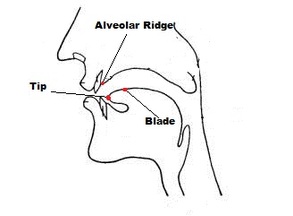Spanish Consonants
|
|
|
Unlike vowel sounds, you create consonant sounds by blocking air from coming out of your mouth. In this section, we'll review some important differences between English and Spanish consonants.
Watch the two videos above and use them as a guide to help you through the first part of this section.
Watch the two videos above and use them as a guide to help you through the first part of this section.
Lateral Consonant "Dark L" /l/
English actually has two "L" sounds: the "dark L" and the "True L." In Spanish, there is only the "True L." A common tendency for English speakers is to use both as if they were speaking English.
Some tips for this consonant:
Some tips for this consonant:
- Keep the same speed when going up and down (la/al, li/il) (3:55)
- Exaggerate by having your jaw as low as possible (4:50)
- Give more love to the consonant, dwell on the /l/ sound (6:20)
Denti-Alveolar Consonants (/t̪/ /d̪/ /n̪/)
In English we create /t/, /d/ and /n/ sounds by touching the tip of the tongue against the upper gumline (alveolar ridge).
In contrast, you make the Spanish /t̪/, /d̪/ and /n̪/ sounds by touching the blade of your tongue (just behind the tip) to this same spot. To do this, you have to stick your tongue out a bit further. This causes your tongue to actually rest between your two rows of front teeth.
Notice the little "tooth" symbol underneath the symbols. We use this to remind you of the difference between these sounds in Spanish.
This may seem like a minor detail, but it is important because certain Spanish sound combinations are IMPOSSIBLE to produce with the English tip-of-the-tongue versions of these consonants. You will need to know how to do this when you get to speaking at faster and faster speeds.
Some tips for these consonants:
In contrast, you make the Spanish /t̪/, /d̪/ and /n̪/ sounds by touching the blade of your tongue (just behind the tip) to this same spot. To do this, you have to stick your tongue out a bit further. This causes your tongue to actually rest between your two rows of front teeth.
Notice the little "tooth" symbol underneath the symbols. We use this to remind you of the difference between these sounds in Spanish.
This may seem like a minor detail, but it is important because certain Spanish sound combinations are IMPOSSIBLE to produce with the English tip-of-the-tongue versions of these consonants. You will need to know how to do this when you get to speaking at faster and faster speeds.
Some tips for these consonants:
- Stick your tongue out a bit further, causing the tip of your tongue to actually rest beneath your upper teeth (1:26)
- Exaggerate and have your tongue all the way out (3:10)
- Practice with the "th" sound from English (7:30)
- Do not let the tongue retreat back into the mouth between consonants
Other Consonants of Note
Soft /b/ and /v/
In Spanish, both the /b/ and /v/ sounds are softened. Spanish speakers do this by touching their lips together for just a brief moment and holding the sound for much less time. In fact, sometimes the lips do not touch each other at all, resulting in a sound like /w/.
As a result, many Spanish speakers will often replace /v/ with /b/. For instance, they may pronounce the word "vaca" as "baca." You will notice that this difference is much slighter than it would be in English.
As a result, many Spanish speakers will often replace /v/ with /b/. For instance, they may pronounce the word "vaca" as "baca." You will notice that this difference is much slighter than it would be in English.
/x/
This sound is common throughout most of the Spanish world. In some dialects it is replaced with the /h/ sound instead. The /x/ sound occurs at the same place that the /k/ sound occurs. It is the sound that most people do when imitating the hiss of a cat or the breathing of Darth Vader. Listen below and try to imitate my speech.
Dialectal Dropped /s/
In some Spanish dialects, the /s/ sound is often dropped or replaced by an /h/ sound. The artist for the final song lesson of this course is Puerto Rican and does this often. So Spanish learners sometimes find it difficult to understand Caribbean varieties of Spanish. It is not that difficult to process, once you tune your ear to it.
/ŋ/
The /ŋ/ sound exists in English and you will recognize it from any word ending in "-ing." In both Spanish and English, this sound occurs before /k/, /g/ or /y/.


